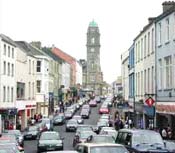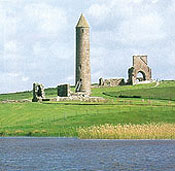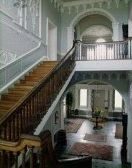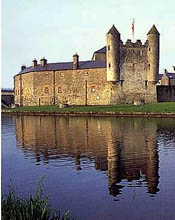 Enniskillen
is the County Town of Fermanagh and is located at the junction of Upper
and Lower Lough Erne. The town centre is in fact located on an island
in the Erne waterway with a number of bridges connecting it to the main
thoroughfares. The main historic attractions within the town include
the Fermanagh History and Heritage Centre and the Regimental Museum
of the Iniskilling Fusiliers. The Heritage Centre contains artifacts
on local farming and manufacturing, whilst the museum is packed with
medals, guns and uniforms of the fusiliers and the dragoon guards. Enniskillen
is the County Town of Fermanagh and is located at the junction of Upper
and Lower Lough Erne. The town centre is in fact located on an island
in the Erne waterway with a number of bridges connecting it to the main
thoroughfares. The main historic attractions within the town include
the Fermanagh History and Heritage Centre and the Regimental Museum
of the Iniskilling Fusiliers. The Heritage Centre contains artifacts
on local farming and manufacturing, whilst the museum is packed with
medals, guns and uniforms of the fusiliers and the dragoon guards.
Fermanagh has a long history of Christian settlements yet the religion
was slow to penetrate the local pagan culture. Viking and Norman invaders
couldn't subdue the region and even the Tudors were unable to do so until
after 1600 - this was when Enniskillen fell to the English. Planters quickly
moved in and a series of castles were established. Enniskillen was soon
transformed into a centre of colonial power. Strategically its importance
to the British led to the town possessing two royal regiments.
The following sites in Co Fermanagh have an historic interest and are
well worth visiting:
Aghalurcher Church, Lisnaskea, Co Fermanagh
St. Ronan, one of the county's important early Christian missionaries,
is said to have founded a church in the 7th century at this spot a mile
and a half south of Lisnaskea, where many Maguire chieftains were buried.
Of greater interest than the ruined church with battered walls are the
18th century gravestones, some kept locked in a stone vault.
A 12th century carving of a figure bearing book and cross, which may
once have adorned a now-vanished tomb-shrine of St. Ronan, is now exhibited
in the Fermanagh County Museum in the Castle at Enniskillen.
 Devenish
Monastic Site Devenish
Monastic Site
This site contains the substantial remains of Lough Erne's most important
island monastery. St Molaise founded it in the 6th century on an historic
pilgrim route to Croagh Patrick. It later became an Augustine Priory of
St Mary. The remains include a Romanesque church and a 12th century round
tower, crosses and the Priory Church. Visitors can climb the islands most
striking feature, the perfect round tower, which is 30 metres tall.
White Island
This island contains the remains of a twelfth century church. Attached
to the North wall of the church are a set of curious stone figures believed
to date to around the 9th or 10th century, there are six carved figures
and a roughly cut stone ready to be carved which suggests the figures
may have been carved on site. To the right of these is a carving of a
head (mask) which may be of a later date. The figures are numbered from
left to right, It was recently suggested that the figures may represent
pilgrims, but whatever the reason for these stone figures they are certainly
very impressive.
 Florence
Court Florence
Court
Situated amongst the mountains and forests of West Fermanagh, Florence
Court is a fascinating example of mid-18th century Irish Palladian architecture.
The present house, the former home of the Earls of Enniskillen, was started
by John Cole and completed around 1775. It was named after Florence, his
wife.
One of the chief glories of Florence Court is the exceptional embellished
rococo plasterwork, seen at its best at the top of the stairs and in the
dining room. This probably dates from 1755 and is in the style of Robert
West, Dublin's leading 18th century stuccodore. The house contains fine
Irish furniture including an 18th century rococo armchair in the library,
an Irish writing cabinet which dates from 1730 and an unusual 18th century
bed.
 Castle
Coole Castle
Coole
On the outskirts of Enniskillen, Co. Fermanagh stands Castle Coole, the
family home of the Earls of Belmore and one of the treasures of the National
Trust. Designed by James Wyatt, this magnificent neoclassical house took
ten years to build. It was completed in 1798.
The interior of the house was created by some of the leading craftsmen
of the late 18th century with chimney pieces carved by Westmacott, plasterwork
created by Rose, scagliola columns and pilasters created by Bartoli. Highlights
of a tour of Castle Coole are the magnificent state rooms with their sumptuous
Regency furnishings. These include the State Bedroom, said to have been
prepared for a visit by George IV in 1821.
The surrounding 700 acre estate is a fitting setting for the house, with
parkland, Lough Coole and extensive woods.
 Enniskillen
Castle Enniskillen
Castle
Nestled amid Fermanagh's lakeland on the banks of the picturesque River
Erne you will find Enniskillen Castle. This fine castle, once the home
of the Gaelic Maguire chieftains, represents an important part of Fermanagh's
rich history and heritage.
Enniskillen Castle presents an array of 19th century barracks buildings
surrounding the Medieval Castle Keep; to the south with its distinctive
turrets is the 17th century Watergate and to the east is the Heritage
Centre built in 1992. Throughout the 16th century the junior branch of
the Maguires ruled Fermanagh from Enniskillen Castle, their stronghold
being captured and retaken many times by the O'Donnells, O'Neills and
the English.
The Heritage Centre exhibits the collections of the County Museum in
award winning displays enhanced by audio visual programmes about Fermanagh's
history, wildlife and landscapes. There are also special exhibitions throughout
the year.
Royal Inniskilling Fusiliers Regimental Museum
Housed in the Castle Keep of Enniskillen Castle the museum has displays
which span the history of the Regiment from its formation in 1689 up to
modern times.
The Collections trace the history of the regiment from its formation in
1689 to amalgamation in 1968. It is illustrated by a large and well laid
out collection of uniforms, weapons, medals, photographs, silver, standards,
badges and other regimental memorabilia. A library containing war diaries
and archival material is available for research purposes by appointment.
Each important part of the Regiment's history is well covered by the collections.
|

